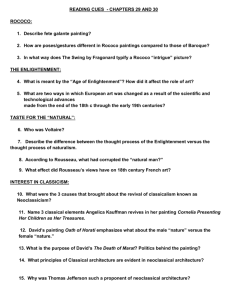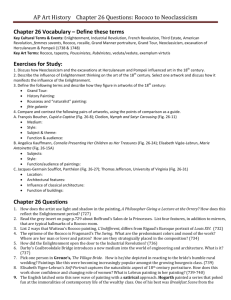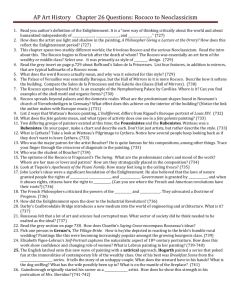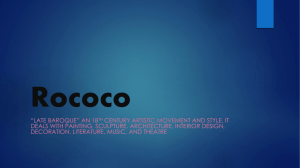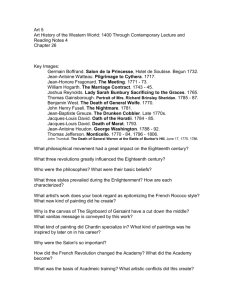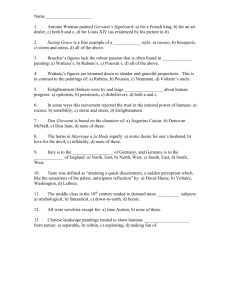File - AP Art History
advertisement
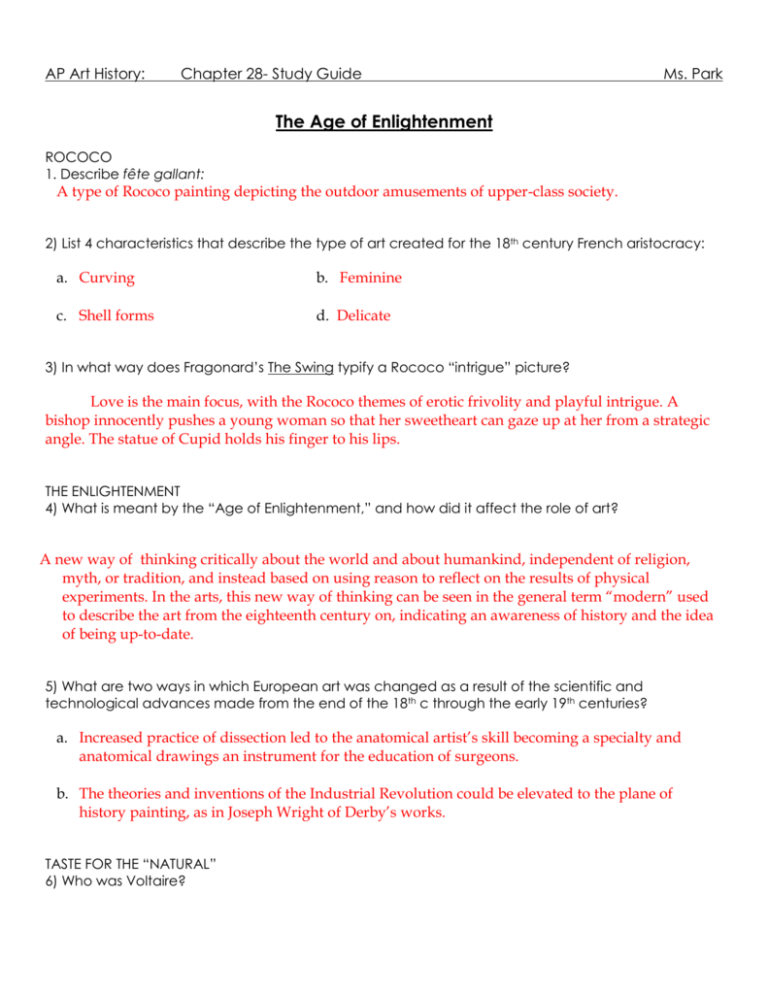
AP Art History: Chapter 28- Study Guide Ms. Park The Age of Enlightenment ROCOCO 1. Describe fête gallant: A type of Rococo painting depicting the outdoor amusements of upper-class society. 2) List 4 characteristics that describe the type of art created for the 18th century French aristocracy: a. Curving b. Feminine c. Shell forms d. Delicate 3) In what way does Fragonard’s The Swing typify a Rococo “intrigue” picture? Love is the main focus, with the Rococo themes of erotic frivolity and playful intrigue. A bishop innocently pushes a young woman so that her sweetheart can gaze up at her from a strategic angle. The statue of Cupid holds his finger to his lips. THE ENLIGHTENMENT 4) What is meant by the “Age of Enlightenment,” and how did it affect the role of art? A new way of thinking critically about the world and about humankind, independent of religion, myth, or tradition, and instead based on using reason to reflect on the results of physical experiments. In the arts, this new way of thinking can be seen in the general term “modern” used to describe the art from the eighteenth century on, indicating an awareness of history and the idea of being up-to-date. 5) What are two ways in which European art was changed as a result of the scientific and technological advances made from the end of the 18th c through the early 19th centuries? a. Increased practice of dissection led to the anatomical artist’s skill becoming a specialty and anatomical drawings an instrument for the education of surgeons. b. The theories and inventions of the Industrial Revolution could be elevated to the plane of history painting, as in Joseph Wright of Derby’s works. TASTE FOR THE “NATURAL” 6) Who was Voltaire? The most representative figure of the Enlightenment, Voltaire was instrumental in introducing Newton and Locke to the French intelligentsia. His writings protested against government persecution of the freedom of thought and religion. 7) According to Rousseau, what had corrupted the “natural man?” The arts, sciences, society, and civilization in general. 8) What effect did Rousseau’s views have on 18th century French art? Rousseau’s views were largely responsible for the turning away from the Rococo sensibility and the formation of a taste for the “natural,” as opposed to the artificial. 9) In contrast to Rococo artificiality, the style of Lebrun’s Self Portrait can be described as: “Natural,” self-confidence of a woman who has won herself an independent role in her society, closeup and intimate. INTEREST IN CLASSICISM 10) Neoclassicism was stimulated by the excavation of the Roman cities of Herculaneum and Pompeii in the mid18th century. 11) Briefly explain the politics behind David’s Death of Marat. In 1793 Jean-Paul Marat, a friend of David’s and a revolutionary radical and writer, was assassinated in the bath by a member of a rival political faction. Narrative details like the knife and the wound are composed to sharpen the sense of pain and outrage and to confront viewers with the scene. It presented Marat to the French people as a tragic martyr who died in the service of the state. The painting functions as an “altarpiece” to the new civic “religion.” 12) In what ways does the Coronation of Napoleon document the relationship between church and state? The painting shows the coronation taking place in Notre Dame Cathedral. Napoleon insisted that David show the pope with his hand raised in blessing. The painting shows the moment just after Napoleon has crowned himself, instead of letting the pope crown him, as was traditional. 13) What neoclassical features are apparent in the painting? The structured composition and the action is presented as on a theater stage. Also, David grouped the figures to represent polarities—the group of the clergy on the right, contrasting with members of Napoleon’s imperial court on the left. 14) Why did Jefferson believe that the Neoclassic style was appropriate for the architecture of the new American republic? He felt the style was representative of the new American democratic qualities. 15) In breaking with David, Ingres adopted a manner that he felt was based on true and pure Greek style. List two characteristics of that style: a. Flat and linear forms approximating those found in Greek vase painting. b. The figures are placed in the foreground, like a piece of low-relief sculpture. 16) Name two Renaissance artists whose influence is apparent in Ingres’ Grande Odalisque: Titian and Parmigianino ROMANTICISM 17) The dates of Romanticism are considered to be between 1750 and ended around 1850. 18) The shift from reason to feeling, from objective nature to subjective emotion, is characteristic of the attitude of mind known as : Romanticism. 19) List three values that were stressed during the so-called Age of Sensibility: a. Political freedom. b. Freedom is the right and property of one and all, though for each individual the kind or degree of freedom might vary. c. Interest in the medieval period and in the sublime. 20) Goya’s work connot be defined to a single stylistic classification. Summarize his varied concerns as expressed in these works: Sleep of Reason Produces Monsters The image of Goya sleeping, threatened by owls and bats (symbols of folly and ignorance) can be seen as a portrayal of what emerges when reason is suppressed and, therefore, advocates Enlightenment ideals. Or it can be read as Goya’s commitment to the creative process and the Romantic spirit—the unleashing of imagination, emotions, and even nightmares. The Third of May It is an emotionally charged scene of French soldiers executing unarmed Spanish peasants. He enhanced the drama with strong darks and lights and extended the time frame through showing some people already dead and others just about to be executed. 21) What is the political message behind Gericault’s Raft of Medusa? The French frigate Medusa crashed off the Africa coast because of the incompetence of the captain, a political appointee; the event was political dynamite when it became public knowledge. Of the 150 original survivors, only fifteen made it to rescue. 22) List three devices he used to add drama to his Raft of Medusa: a. Instead of the straightforward organization of Neoclassical compositions, Gericault used a jumble of writhing bodies. b. They are arranged in an X-shaped composition with one light axis and one dark axis. c. Subdued palette and prominent shadows. 23) What political event did Delacroix depict in Liberty Leading the People? The Parisian uprising against the rule of Charles X at the end of July 1830. LANDSCAPE PAINTING 24) How does Turner’s Slave Ship reflect the practices of 19th century slave traders? What are three characteristics of Turner’s style? It depicts a scene from a book about the slave trade that described how one captain threw sick and dying slaves overboard so he could recoup full reimbursement for their lives. Turner depicts the scene in an emotional and frenzied way to match the barbarism of the act. a. Vast scale. b. Hazy forms and indistinct c. Emotive power of pure compositions to focus interest color. on the color and energy. ARCHITECTURE 25) What style did Barry and Pugin use for the rebuilding of the Houses of Parliament in London? English Late Gothic/Neo-Gothic. 26) Describe the effect of the use of iron on 19th century architectural structures: The tensile effect of iron and steel permitted architects to create new designs involving vast enclosed spaces, as in the great train sheds of railroad stations and in exposition halls. 27) What is the significance of the techniques used by Paxton to construct the Crystal Palace? He used the glass-and-iron construction methods of greenhouses on a massive scale, a plan based on basilicas with a central flat-roofed “nave,” and a barrel-vaulted crossing “transept.” The building was made with prefabricated parts, allowing it to be erected quickly and reerected at another location after the exhibition. PHOTOGRAPHY 28)What is the difference between camera obscura and the camera lucida? The camera obscura is a closed chamber in which a tiny pinhole, acting as a lens, projects an image onto a surface. The camera lucida is a small prism lens, hung on a stand and aimed downward at an object. The lens projects the image of the object onto a sheet of paper. 29) When did Daguerre present his new photographic process in Paris? At the Academy of Science on January 7, 1839. 30) Describe the Daguerrotype process: A metal plate covered with a light-sensitive chemical coating is exposed in a camera obscura. 31) How did artists react to Daguerre’s invention? They were intrigued with the possibilities of the process as a new art medium. Paul Delaroche, a painter, said it “completely satisfies all the demands of art.” 32) What is a calotype? A photographic images produced when negative images are created by placing objects on sensitized paper and exposing the arrangement to light. This creates a design of light-colored silhouettes recording the places where opaque or transparent objects had blocked light from darkening the paper’s emulsion. Next, sensitized papers are exposed inside simple cameras or by chemical development, creating positive images. Multiple prints can be made with a chemical development of the negative image. Discussion Questions 33) Compare Fragonard’s The Swing with Bronzino’s Cupid, Folly and Time. Although both works have strong erotic overtones, they are very different in their emotional effects. What makes one Rococo and the other Mannerist? 34) Compare Ingres’ Grande Odalisque with Titian’s Venus of Urbino. How do they differ in composition, body type, distortion, and degree of idealization?
